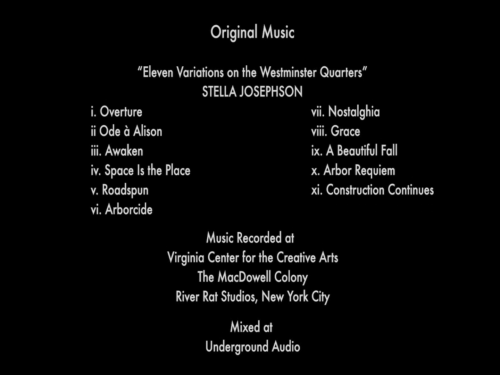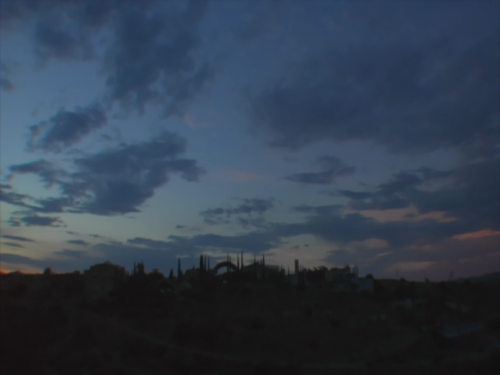If you’ve seen the film and you’re the kind of person who pays attention to credits, you may have seen this:

Screenshot from A Life’s Work credits.
Who is this Stella Josephson, you ask?
And where is River Rat Studios? Well, I’m Stella Josephson and River Rat Studios is a small vestibule between the living room and bedroom in my apartment. (A professional mixer, Matt Rocker mixed the music tracks at Underground Audio, an excellent studio. He did a great job and I can’t thank him enough.)
Why did I use a pseudonym? Because I felt my name was in the credits way too much as it is. And how did I come up with the name? Not important. And that’s not really interesting commentary.
But maybe this is. Below are four excerpts, totaling 2 minutes, from the … oh gosh, I guess I have to call it, the film score.
With the exception of some pre-recorded sounds taken from NASA’s audio library that I buried in the music for the SETI sequences, and maybe a singing bowl and some bells, the music is composed entirely on the guitar. That’s obvious in the first excerpt, a little less obvious in the second, and not too obvious in the third excerpt.
But what about the fourth bit?
Original music from A Life’s Work: Roadspun, Nostalghia, Arbor Requiem, Construction Continues
A Piano?
After one hour and 20 minutes of guitar music in all its manipulated glory, a keyboard is finally heard. That was recorded at the MacDowell Colony on the grand piano in the Sprague-Smith studio. (Click to see who worked in that studio, before and after a fire burned it down. I am not worthy.)
So why?
At about 1 hour 18 minutes and 20 seconds we see a time lapse long shot of Arcosanti, going from dusk to the dark night in about 25 seconds. Night fades out completely until the screen is black for a long 3.5 seconds. In cinematic language, that kind of transition is suggesting to the viewer, whether they realize it or not, that one chapter has ended and a new one is about to begin. And since this is the pivotal moment in the film, I wanted the music to accentuate that idea.

Screenshot of Arcosanti.
If you noticed all this during your initial viewing, then I have failed. I do not want the music to draw attention to itself. I don’t want you to lean over to your companion and say, “Interesting, did you notice this is the first time we’re hearing a keyboard,” because if you do, you are not fully engaged with the film.* But hopefully, like the long fade out, this works on a subliminal level, the way a complex meal does not always reveal all of its spices.
*Unless you are a big giant film nerds who lives for that kind of thing.
Questions?
Do you have a question? Drop it in the comments. I love hearing from you.

Bill
STELLA !!!!
(Did not see an easy way to insert picture of Marlon Brando in “A Streetcar Named Desire”).
Interesting! Thanks.
David Licata
Ha ha!!!!